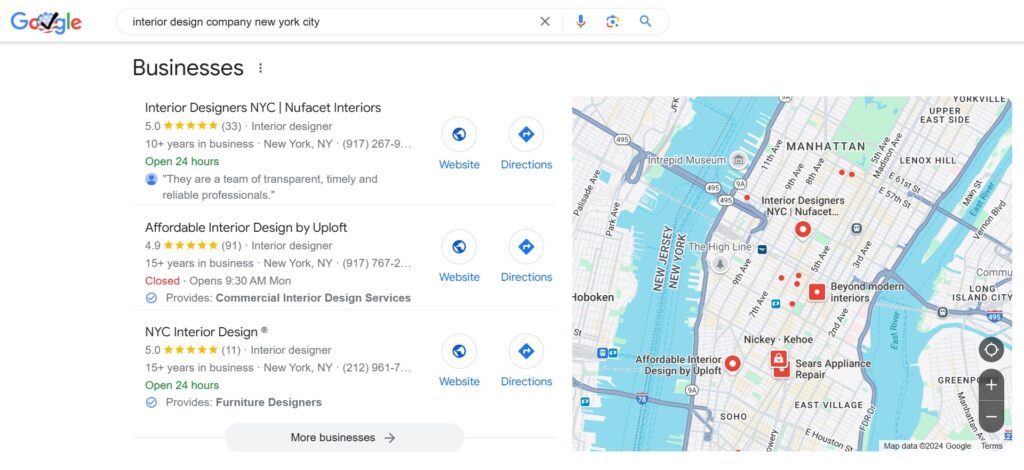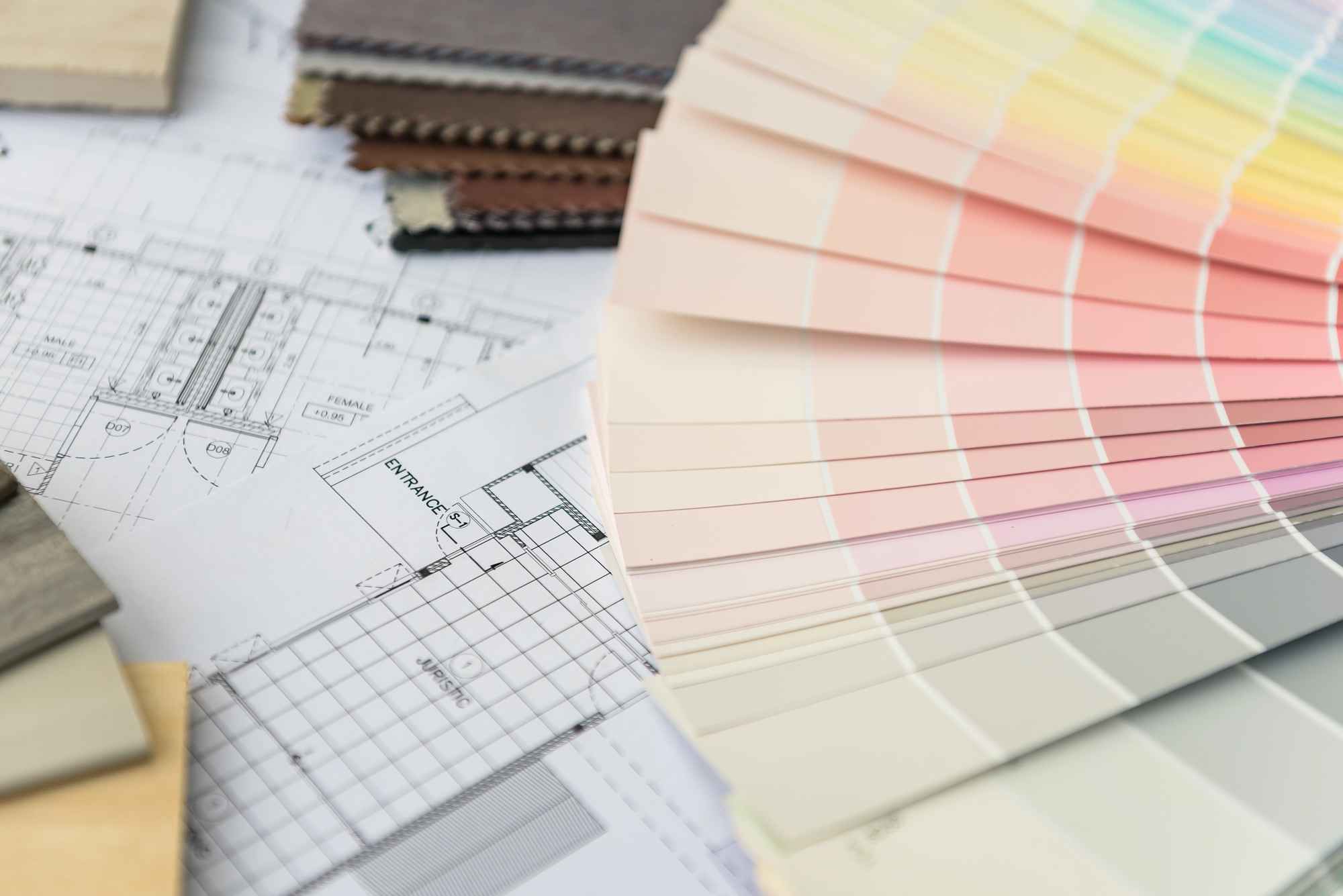Finding new clients for your interior design business can be challenging, and it’s frustrating when your competitors are showing up higher than you in local searches. That’s where local SEO comes into play, helping you stand out in a crowded marketplace and connect with homeowners who need your expertise.
In this guide, we’ll explore practical local SEO strategies specifically for interior designers, from optimizing your Google Business Profile to your website.
Succeeding in local SEO isn’t rocket science, but it does take some elbow grease. With consistent effort, you can generate local leads to your website very affordably.
Understanding Local SEO
So, what exactly is local SEO? In simple terms, local SEO is a digital marketing strategy that helps businesses improve their online visibility in local search results.
For interior designers, this means ensuring that when potential clients search for design services in their area, your name pops up prominently.
Local SEO focuses on optimizing your online presence to attract more customers from relevant local searches. This includes creating and maintaining a Google Business Profile, which serves as your business’s digital storefront on Google, making it easier for clients to find you. Additionally, managing customer reviews is necessary; positive feedback not only boosts your credibility but also enhances your visibility in search results.
Lastly, optimizing your website with local keywords, engaging content, and easy navigation can help solidify your position as a go-to interior designer in your community. Together, these elements can significantly elevate your online presence and connect you with more clients looking for your unique design touch.
Setting Up, Optimizing, and Managing Your Google Business Profile

Setting up a Google Business Profile (formerly Google My Business, or GMB) for your interior design business is a straightforward process, but it’s important to get it right to maximize your online visibility. Start by entering your real business name; resist the temptation to stuff keywords into your name. This violates Google’s guidelines and it can get your GBP banned. Next, keep your physical address visible. Keeping your address listed is essential, as it directly impacts your GBP’s reach—without it, you risk being invisible to local searchers.
Once you’ve established the basics, provide your phone number, email address, and website. Selecting the right category is also important; for most interior designers, “interior designer” is the primary category. You can further refine your profile by choosing secondary categories, with “interior decorator” being a popular choice among designers. This helps Google understand the services you offer and match you with relevant searches.
Visual content is key in the interior design industry, so populate your Google Business Profile with high-quality photos and videos that showcase your work. Display images of your projects, your branding, and even behind-the-scenes glimpses of your design process. This not only helps potential clients get a feel for your style but also adds credibility to your business. Remember, you want to paint a picture of what it’s like to work with you, so include a diverse range of your past projects that highlight your unique aesthetic and capabilities.
Another significant factor in the success of your Google Business Profile is customer reviews. Positive reviews not only boost your credibility but also improve your ranking in local search results. Encourage satisfied clients to leave reviews and make it easy for them to do so by providing them with your review link. Responding to reviews—both positive and negative—shows potential clients that you value feedback and are engaged with your clientele.
Regularly updating your profile is essential for maintaining its effectiveness. This means adding new photos, responding to reviews, and keeping your information current. If you’ve launched new services, completed exciting projects, or changed your contact details, reflect those changes on your GBP. Google favors active profiles, so keeping yours fresh can help enhance your visibility in local searches.
Another thing you can take advantage of is the posts feature on your Google Business Profile. This allows you to share updates about your business, highlight recent projects, or announce special promotions. These posts can keep your audience engaged and provide valuable information to potential clients. They also show Google that you’re active, which can positively influence your search ranking.
By carefully setting up, optimizing, and managing your Google Business Profile, you position your interior design business for greater online visibility and connect with local clients searching for your unique talents.
The Importance of Positive Reviews & Reputation Management as an Interior Designer
Positive reviews are essential to the success of your Google Business Profile, as they help boost your visibility and build trust with potential clients. Interior design business owners should make it a habit to respond to all reviews—showing appreciation for positive feedback and professionally addressing any negative comments.
To gather reviews, consider asking past clients directly, either through a polite follow-up email or by sharing a review link to make the process easier. You can also encourage reviews by including a reminder with the final receipt or having team members mention it in person.
Keyword Research for Interior Designers
To get started with local keyword research for your interior design company, you’ll need a reliable keyword research tool that fits your budget. If you’re just starting out, affordable tools like Keysearch or Keyword Chef can give you solid insights without breaking the bank. For those seeking more in-depth functionality, tools like Ahrefs or SEMRush offer powerful options, though they come with a higher price tag and additional features you may not need at this stage.
Once you’ve selected a tool, begin by entering “seed keywords,” which are simple terms like “interior design + [your location]” or “interior decorator + [location].” These foundational keywords are often the main focus for your location pages, as they tend to have the highest search volume and are what potential clients are likely to type into search engines.
After you’ve nailed down your main keywords, dive deeper by identifying secondary keywords. These are often related terms that add depth to your content and help capture a broader range of search queries. Think phrases like “modern interior design [location]” or “residential interior decorator [location].” Strategically placing these secondary keywords throughout your website and content helps boost relevancy and can improve your chances of ranking for related searches.
This process of keyword research gives you a general roadmap to find terms your ideal customers search for. Next, you’ll need to ensure you target these keywords thoughtfully on your website.
Structuring a Local SEO-Friendly Website for Interior Design Companies
Creating an effective website structure is key to ranking well in local search results for your interior design business. The first step is to identify a primary keyword that best represents your business, like “interior design company Kansas City,” and optimize your homepage around this term. This gives search engines a clear understanding of your website’s focus. Beyond the homepage, it’s often beneficial to create separate location pages targeting services in surrounding areas—this way, each page can focus on capturing searches from a specific city or neighborhood.
When building out these location pages, there’s no one-size-fits-all structure, as it really depends on the services you offer and your local market. The most important thing is to avoid targeting the same keyword on multiple pages, which can cause “keyword cannibalization,” where your pages compete against each other in search rankings and end up lowering overall visibility. Instead, choose a unique primary keyword or topic for each page to ensure your content is relevant and optimized.
With a well-planned structure, your website can capture a range of local searches and connect with more clients across your service area.
On-Page SEO Strategies to Boost Your Interior Design Website
On-page SEO is an essential part of getting your interior design website noticed by search engines and potential clients. This process begins with selecting a primary keyword or topic to target on each page, as discussed in the previous section. Alongside this primary keyword, you’ll also want to incorporate synonyms and related terms naturally throughout your content to help Google understand the context and variety of services you offer. For the best results, include your primary keyword in these areas: the title tag, meta description, one of the H2 headings, and naturally a few times within the page copy.
A more advanced technique in on-page SEO is what’s known as entity optimization. Unlike traditional keywords, entities are terms and concepts related to your main keyword that help paint a fuller picture of your topic. For instance, if your target keyword is “interior design company Kansas City,” Google might expect to see related phrases such as “modern decor”. Many of these terms will appear naturally in your content if you’re covering the subject in-depth, but you can also identify additional entities with on-page SEO tools like SurferSEO or Frase.io.
These tools analyze top-ranking pages for your target keywords and reveal which entities are commonly included, helping you refine your content’s relevance without overstuffing keywords. Even if you’re an expert in interior design, using on-page SEO tools can give you insight into terms that may enhance your page’s chances of ranking well.
Incorporating these strategic on-page SEO practices can make a real difference in how search engines perceive your website, helping it reach the right audience and convert visitors into clients.
Building Citations and Earning Backlinks for Your Interior Design Website
A ranking factor for local SEO is creating citations—mentions of your business’s name, address, and phone number on sites like Yelp, Yellow Pages, and other local directories. You can add these manually or streamline the process using a tool like BrightLocal. While citations alone don’t drastically boost your rankings, they add legitimacy by showing Google that your business has a solid local presence, making it more likely to recommend you to nearby searchers.
Backlinks are links from other websites that boost your rankings. When other reputable websites link back to your site, it’s like a vote of confidence in your expertise, and search engines like Google and Bing use these signals to gauge your website’s authority. Although building high-quality backlinks takes time and effort, the payoff is worth it. Aim to earn links from local news outlets, interior design industry sites, or reputable blogs.
Some effective backlink strategies include guest posting on relevant sites, creating link-worthy content like interior design industry statistics or trend reports, and using digital PR to promote your unique perspectives or projects. These approaches not only help build your reputation online but also improve your chances of ranking higher in search results, driving more local clients to your website.
Why Mobile Optimization Matters for Interior Design Websites
In today’s digital landscape, having a mobile-friendly website is essential for interior design businesses. With most visitors accessing your site from mobile devices, a seamless, responsive design ensures that potential clients can easily view your portfolio, contact information, and services on the go.
A well-optimized mobile experience not only improves user satisfaction but also positively impacts your rankings on search engines like Google. Prioritizing mobile optimization helps you stay competitive and accessible to your audience wherever they are.
Building a Strong Local SEO Strategy for Your Interior Design Business
Implementing a consistent, well-rounded local SEO strategy is key to driving traffic and attracting clients to your interior design business. By optimizing your website and managing your Google Business Profile, you can boost your visibility and connect with clients searching for interior design expertise in your area.
Local SEO is an ongoing process that requires attention to detail and a strategic, consistent approach.
At Galactic Turtle, we offer local SEO services for interior designers. We’re here to help interior design companies establish a powerful online presence and generate more leads, so you can focus on transforming spaces while we handle the technical side.
You can contact us here and we’ll get the ball rolling.
